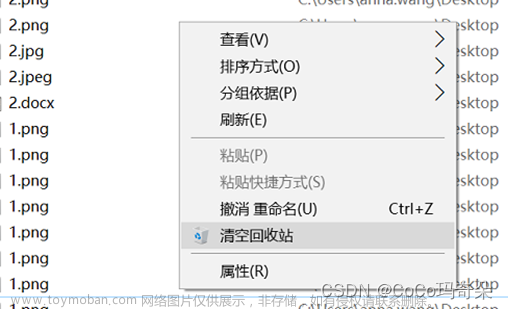一、回收站 Trash 机制开启
HDFS本身是一个文件系统,默认情况下HDFS不开启回收站,数据删除后将被永久删除
添加并修改两个属性值可开启Trash功能 - (core-site.xml)
<property>
<name>fs.trash.interval</name>
<value>1440</value>
</property>
注:Trash分钟数,当超过分钟数后检查点会被删除,默认值为0,为0时Trash功能将被禁用
<property>
<name>fs.trash.checkpoint.interval</name>
<value>0</value>
</property>
注:检查点的创建时间间隔(单位为分钟数),其值应该小于或等于 fs.trash.internal。默认为0,为0时,该值设置为 fs.trash.internal的值
以上两参数的作用:当NameNode启动后,会启动一个守护线程,每隔【fs.trash.checkpoint.interval】的时间会在【.Trash】目录下创建当前时间的检查点,把最近删除的数据放在此检查点内,并在【fs.trash.interval】的周期去将过期的检查点删除
注:检查点 【Trash checkpoint】 : 1.检查点仅仅是用户回收站下的一个目录,用于存储在创建检查点之前删除的所有文件或目录。和 Current 同级目录/user/deploy/.Trash/{timestamp_of_checkpoint_creation}
2.删除的文件被移动到回收站Current目录,并且在可配置的时间间隔内,HDFS会为在Current回收站目录下的文件创建检查点/user/${username}/.Trash/<创建日期>,并在过期时删除旧的检查点。
图为:官网参数描述

图为 .Trash 下的目录
二、回收站 Trash 功能机制使用
当用户开始回收站后,从HDFS删除的文件或目录不会立即被清除,会被移动到回收站Current目录中:/user/deploy/.Trash/Current,当然还可以使用命令,跳过回收站进行删除,将数据直接永久删除
-- 1.删除 HDFS 数据
hadoop fs -rm -r -f /user/hive/external/dwd/dwd_test
-- 2.恢复误删除的文件
hadoop fs -mv /user/deploy/.Trash/Current/user/hive/external/dwd/dwd_test /user/hive/external/dwd/dwd_test
-- 3.强制删除数据不进入回收站
hadoop fs -rm -r -f -skipTrash /user/hive/external/dwd/dwd_test
-- 4.手动删除回收站文件
hadoop fs -rm -r -f /user/deploy/.Trash/Cureent/user/hive/external/dwd/dwd/dwd_test
-- 5,清空 HDFS 的回收站
hadoop fs -expunge (hdfs dfs -expunge 命令只会创建新的checkpoint,不会删除过期的checkpoint)
1.Hadoop 官方文档命名的说明-检查点 Checkpoints 的创建与删除
expunge
Usage: hadoop fs -expunge [-immediate] [-fs <path>]
Permanently delete files in checkpoints older than the retention threshold from trash directory, and create new checkpoint.
-- 永久删除超过阈值的检查点中文件,并创建新的检查点
When checkpoint is created, recently deleted files in trash are moved under the checkpoint. Files in checkpoints older than fs.trash.interval will be permanently deleted on the next invocation of -expunge command.
-- 当检查点被创建了,最近删除的数据会被移动到检查点中,在下次执行 expunge 时过期的checkpoint会被永久删除
If the file system supports the feature, users can configure to create and delete checkpoints periodically by the parameter stored as fs.trash.checkpoint.interval (in core-site.xml). This value should be smaller or equal to fs.trash.interval.
-- 如果文件系统支持该特性,用户可以配置通过存储在fs.trash.checkpoint.interval(在core-site.xml中)中的参数定期创建和删除检查点。这个值应该小于或等于fs.trash.interval。
If the -immediate option is passed, all files in the trash for the current user are immediately deleted, ignoring the fs.trash.interval setting.
If the -fs option is passed, the supplied filesystem will be expunged, rather than the default filesystem and checkpoint is created.
For example
hadoop fs -expunge --immediate -fs s3a://landsat-pds/
2.操作如下,执行命令会先进行删除已达到过期时间的 checkpoint ,然后会创建新的checkpoint,将最近删除的数据放入 
图为 手动执行hadoop fs -extunge时先delete检查点,后create检查点的
三、回收站 Trash工作原理-源码
1.1 初始化
NameNode启动时会在后台启动一个emptier守护线程,用于定时(NameNode重启周期清零)清理HDFS集群上每个用户下的回收站数据,定时周期为 fs.trash.checkpoint.interval。
源码路径:org.apache.hadoop.hdfs.server.namenode
private void startTrashEmptier(final Configuration conf) throws IOException {
long trashInterval =
conf.getLong(FS_TRASH_INTERVAL_KEY, FS_TRASH_INTERVAL_DEFAULT);
if (trashInterval == 0) {
return;
} else if (trashInterval < 0) {
throw new IOException("Cannot start trash emptier with negative interval."
+ " Set " + FS_TRASH_INTERVAL_KEY + " to a positive value.");
}
// This may be called from the transitionToActive code path, in which
// case the current user is the administrator, not the NN. The trash
// emptier needs to run as the NN. See HDFS-3972.
FileSystem fs = SecurityUtil.doAsLoginUser(
new PrivilegedExceptionAction<FileSystem>() {
@Override
public FileSystem run() throws IOException {
return FileSystem.get(conf);
}
});
this.emptier = new Thread(new Trash(fs, conf).getEmptier(), "Trash Emptier");
this.emptier.setDaemon(true);
this.emptier.start();
}调用Trash类初始化配置信息和垃圾回收策略。
源码路径:org.apache.hadoop.fs.Trash
public Trash(FileSystem fs, Configuration conf) throws IOException {
super(conf);
trashPolicy = TrashPolicy.getInstance(conf, fs, fs.getHomeDirectory());
}HDFS为每个执行用户创建一个专属主目录/user/$USER/,被删除的数据会移动到执行用户的主目录下。
源码路径:org.apache.hadoop.fs.FileSystem
/** Return the current user's home directory in this filesystem.
* The default implementation returns "/user/$USER/".
*/
public Path getHomeDirectory() {
return this.makeQualified(
new Path("/user/"+System.getProperty("user.name")));
}通过反射创建TrashPolicy对象,垃圾回收策略可以用户自定义实现,通过参数fs.trash.classname指定。系统默认使用TrashPolicyDefault.class。
源码路径:org.apache.hadoop.fs.TrashPolicy
public static TrashPolicy getInstance(Configuration conf, FileSystem fs, Path home) {
Class<? extends TrashPolicy> trashClass = conf.getClass(
"fs.trash.classname", TrashPolicyDefault.class, TrashPolicy.class);
TrashPolicy trash = ReflectionUtils.newInstance(trashClass, conf);
trash.initialize(conf, fs, home); // initialize TrashPolicy
return trash;
}2.2 启动定时线程
NameNode通过this.emptier.start()方法启动线程,emptier线程周期性休眠后唤醒,执行删除垃圾数据trashPolicy.deleteCheckpoint()和创建检查点trashPolicy.createCheckpoint()操作。
源码路径:org.apache.hadoop.fs.TrashPolicy
@Override
public void run() {
if (emptierInterval == 0)
return; // trash disabled
long now = Time.now();
long end;
while (true) {
end = ceiling(now, emptierInterval);
try { // sleep for interval
Thread.sleep(end - now);
} catch (InterruptedException e) {
break; // exit on interrupt
}
try {
now = Time.now();
if (now >= end) {
FileStatus[] homes = null;
try {
homes = fs.listStatus(homesParent); // list all home dirs
} catch (IOException e) {
LOG.warn("Trash can't list homes: "+e+" Sleeping.");
continue;
}
for (FileStatus home : homes) { // dump each trash
if (!home.isDirectory())
continue;
try {
TrashPolicyDefault trash = new TrashPolicyDefault(
fs, home.getPath(), conf);
trash.deleteCheckpoint(); //删除垃圾数据
trash.createCheckpoint(); //创建检查点
} catch (IOException e) {
LOG.warn("Trash caught: "+e+". Skipping "+home.getPath()+".");
}
}
}
} catch (Exception e) {
LOG.warn("RuntimeException during Trash.Emptier.run(): ", e);
}
}
try {
fs.close();
} catch(IOException e) {
LOG.warn("Trash cannot close FileSystem: ", e);
}
}2.3 删除垃圾数据
检查/user/${user.name}/.Trash/(所有用户)下的第一级子目录,将目录名为格式yyMMddHHmmss的目录转化为时间 time(跳过Current和无法解析的目录),如果符合条件(now - deletionInterval > time),则删除该目录 (deletionInterval = ${fs.trash.interval})。回收站的默认清理机制粒度比较粗,只针对/user/${user.name}/.Trash/下的第一级子目录.
public void deleteCheckpoint() throws IOException {
FileStatus[] dirs = null;
try {
dirs = fs.listStatus(trash); // scan trash sub-directories
} catch (FileNotFoundException fnfe) {
return;
}
long now = Time.now();
for (int i = 0; i < dirs.length; i++) {
Path path = dirs[i].getPath();
String dir = path.toUri().getPath();
String name = path.getName();
if (name.equals(CURRENT.getName())) // skip current
continue;
long time;
try {
time = getTimeFromCheckpoint(name); //将目录名转换为时间
} catch (ParseException e) {
LOG.warn("Unexpected item in trash: "+dir+". Ignoring.");
continue;
}
if ((now - deletionInterval) > time) {
if (fs.delete(path, true)) { //删除目录
LOG.info("Deleted trash checkpoint: "+dir);
} else {
LOG.warn("Couldn't delete checkpoint: "+dir+" Ignoring.");
}
}
}
}2.4 创建检查点
如果/user/${user.name}/.Trash/目录下存在Current目录,则将该目录重命名为yyMMddHHmmss(执行到该条代码的当前时间)。如果不存在Current目录,则直接跳过。重命名后,新的删除数据写入时仍会创建Current目录。
public void createCheckpoint() throws IOException {
if (!fs.exists(current)) // no trash, no checkpoint
return;
Path checkpointBase;
synchronized (CHECKPOINT) {
checkpointBase = new Path(trash, CHECKPOINT.format(new Date()));
}
Path checkpoint = checkpointBase;
int attempt = 0;
while (true) {
try {
fs.rename(current, checkpoint, Rename.NONE); //重命名目录
break;
} catch (FileAlreadyExistsException e) {
if (++attempt > 1000) {
throw new IOException("Failed to checkpoint trash: "+checkpoint);
}
checkpoint = checkpointBase.suffix("-" + attempt);
}
}
LOG.info("Created trash checkpoint: "+checkpoint.toUri().getPath());
}四、特殊案例
集群配置垃圾回收参数如下:
fs.trash.interval = 4320 //3天 fs.trash.checkpoint.interval = 0 //未自定义设置,
fs.trash.checkpoint.interval=${fs.trash.interval}
2018:11:27 08:00:00开始唤醒emptier线程,先执行deleteCheckpoint()方法,理想情况下应该是符合条件((now - deletionInterval) > time)。
now:大于181127080000,小于181127080010的某个时间点
deletionInterval:4320 minutes
time:181124080000 => 符合条件,开始删除181124080000目录而在现实操作中,往往会发生如下极端情况:

now:大于181127080000,小于181127080010的某个时间点
deletionInterval:4320 minutes
time:181124080033 => 不符合条件,跳过执行createCheckpoint()方法
fs.trash.checkpoint.interval默认不设置的情况下,会出现本来设置回收站数据保存3天,而实际上会保留接近9天的情况。五、expunge命令
用户可以通过手动执行hadoop shell命令清理过期检查点和创建新的检查点,功能同emptier线程的单次执行。
hdfs dfs -expunge
hadoop fs -expunge源码路径:org.apache.hadoop.fs.shell文章来源:https://www.toymoban.com/news/detail-767749.html
protected void processArguments(LinkedList<PathData> args)
throws IOException {
Trash trash = new Trash(getConf());
trash.expunge();
trash.checkpoint();
}源码路径:org.apache.hadoop.fs.Trash文章来源地址https://www.toymoban.com/news/detail-767749.html
/** Delete old checkpoint(s). */
public void expunge() throws IOException {
trashPolicy.deleteCheckpoint();
}到了这里,关于HDFD 回收站【Trash】机制的文章就介绍完了。如果您还想了解更多内容,请在右上角搜索TOY模板网以前的文章或继续浏览下面的相关文章,希望大家以后多多支持TOY模板网!






![[计算机入门] 回收站](https://imgs.yssmx.com/Uploads/2024/02/620144-1.png)





